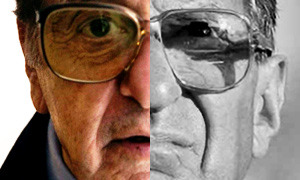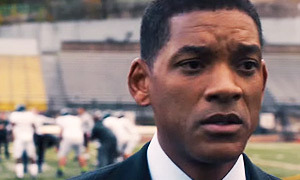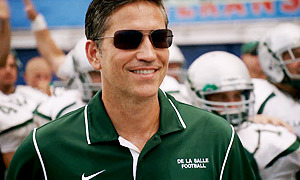Concussion: History vs. Hollywood
| REEL FACE: | REAL FACE: |
Will Smith
Born: September 25, 1968 Birthplace: Philadelphia, Pennsylvania, USA | Dr. Bennet Omalu
Born: September 1968 Birthplace: Nnokwa, Idemili South, Nigeria |
Gugu Mbatha-Raw
Born: April 21, 1983 Birthplace: Oxford, Oxfordshire, England, UK | Prema Mutiso
Birthplace: Nairobi, Kenya |
Alec Baldwin
Born: April 3, 1958 Birthplace: Massapequa, Long Island, New York, USA | Dr. Julian Bailes
Born: July 4, 1956 |
Albert Brooks
Born: July 22, 1947 Birthplace: Beverly Hills, California, USA | Cyril Wecht
Born: March 20, 1931 Birthplace: Dunkard Township, Pennsylvania, USA |
David Morse
Born: October 11, 1953 Birthplace: Hamilton, Massachusetts, USA | Mike Webster
Born: March 18, 1952 Birthplace: Tomahawk, Wisconsin, USA Death: September 24, 2002, Pittsburgh, Pennsylvania, USA (heart attack) Position: center / Steelers |
Luke Wilson
Born: September 21, 1971 Birthplace: Dallas, Texas, USA | Roger Goodell
Born: February 19, 1959 Birthplace: Jamestown, New York, USA Position: NFL Commissioner |
Paul Reiser
Born: March 30, 1957 Birthplace: New York City, New York, USA | Dr. Elliot Pellman
Position: NFL Concussion Committee Chairman / Rheumatologist / Attended medical school in Guadalajara, Mexico |
Matthew Willig
Born: January 21, 1969 Birthplace: La Mirada, California, USA | Justin Strzelczyk
Born: August 18, 1968 Birthplace: West Seneca, New York, USA Death: September 30, 2004, Herkimer, New York, USA (car chase accident) Position: offensive tackle / Steelers |
Bitsie Tulloch
Born: January 19, 1981 Birthplace: San Diego, California, USA | Keana Strzelczyk
Born: November 22, 1972 Birthplace: USA |
Richard T. Jones
Born: January 16, 1972 Birthplace: Kobe, Hyōgo Prefecture, Japan | Andre Waters
Born: March 10, 1962 Birthplace: Belle Glade, Florida, USA Death: November 20, 2006, Tampa, Florida, USA (suicide by gunshot to head) Position: safety / Eagles |
Adewale Akinnuoye-Agbaje
Born: August 22, 1967 Birthplace: Islington, London, England, UK | Dave Duerson
Born: November 28, 1960 Birthplace: Muncie, Indiana, USA Death: February 17, 2011, Sunny Isles Beach, Florida, USA (suicide by gunshot to chest) Position: safety / Bears |
Arliss Howard
Born: October 18, 1954 Birthplace: Independence, Missouri, USA | Dr. Joseph Maroon
Born: May 26, 1940 Birthplace: USA |
Stephen Moyer
Born: October 11, 1969 Birthplace: Brentwood, Essex, England, UK | Dr. Ronald Hamilton
Birthplace: USA |
Eddie Marsan
Born: June 9, 1968 Birthplace: Stepney, London, England, UK | Dr. Steven DeKosky
Born: March 23, 1947 Birthplace: USA |
Did Dr. Bennet Omalu discover the disease while studying the brain of former NFL player Mike Webster?
Yes. Mike Webster, nicknamed "Iron Mike," was a former center for the Pittsburgh Steelers who passed away of a heart attack in 2002 at age 50. Like in the Concussion movie, he had spent years battling depression, dementia, amnesia, and severe back pain. The real Bennet Omalu discovered CTE (Chronic Traumatic Encephalopathy) while trying to make sense of why Webster's symptoms were present at his relatively young age.
Did Mike Webster really live out of his truck?
Yes. The Concussion true story confirms that Pro Football Hall of Fame member Mike Webster did live out of his pickup truck for a period of 18 months, but according to Webster, he wasn't exactly homeless. "From time to time, yes, I did sleep in my car and stay in my car," Webster admitted to The St. Petersburg Times in the late 1990s. "There's a broad definition of what living out of your car is. And yes, I slept in a train station one time. I had some things to think through. I wasn't broke. I wasn't in danger. I was just out of gas, tired and exhausted, and that's as far as I got that day." At some point, as seen in the film, one of his truck windows had been replaced with a garbage bag and tape (GQ).
Did Mike Webster really knock himself out with a Taser so that he could sleep?
Yes. The real Mike Webster had become so plagued by chronic back pain that he bought a stun gun so that he could zap his leg, sometimes up to a dozen times, to knock himself out (ESPN.com). The movie shows him on the autopsy table right after zapping himself, falsely implying that he Tasered himself to death (other factors, including his lifestyle and drug use, were the more likely causes of his heart attack). He died in Allegheny General Hospital's coronary care unit in Pittsburgh. As mentioned in the movie, he had also Super-Glued his rotting teeth (GQ).
Did Dr. Omalu really talk to his patients?
Yes. "There's a practice I have. I'm a spiritual person. I'm a Catholic," says the real Dr. Bennet Omalu. "I treat my patients, the dead patients, as live patients. I believe there's life after death. And I talk to my patients. I talk to them, not loudly, but quietly in my heart when I look at them. Before I do an autopsy, I must have a visual contact with the face. I do that. I'll come out of respect; I'll look at the face."
He continued, "I saw [Mike Webster] was embalmed. He looked older than his age. And I said to him, 'Mike, you need to help me. You need to help me. Let's prove them wrong. You're a victim of football, but you need to help me, wherever you are. I can't do this by myself. I'm a nobody, but you need to help me. Let's prove them wrong.'" -PBS.org
Is Omalu's adversary at the coroner's office based on a real person?
No. In researching the Concussion true story, we discovered that Omalu's coworker in the movie, Daniel Sullivan (Mike O'Malley), is a fictional character who opposes Omalu's unorthodox methods, including talking to cadavers (the real Omalu did that). Sullivan is also a voice for the Pittsburgh Steelers faithful, many of whom would oppose seeing one of their heroes, Mike Webster, cut open and dissected.
In real life, Dr. Bennet Omalu felt embarrassed for obsessing over one brain for so long, sometimes staying at work until 2 a.m. to study Webster's brain. Worried what his coworkers were thinking, he decided to take the brain home to his condo in the borough of Churchill near Pittsburgh. -GQ
Do football players really get hit with a force of up to 100 g's?
Yes. The movie implies it is common for football players to take hits with a force of 100 g's. According to a study published by the University of Oklahoma, that much force is seen mainly in cases where receivers are blindsided in the open field. More common cases of football players being knocked out occur at roughly sixty to ninety g's. By comparison, fighter pilots lose consciousness after enduring five or six g's over an extended period of time. The study found that linemen get hit with a force of twenty to thirty g's on every snap, mainly because they start out by ramming heads. Former Steelers center Mike Webster, Omalu's patient zero, endured an estimated 25,000 violent collisions over the course of his career. -GQ
Is Omalu's girlfriend Prema based on a real person?
Yes. Prema Mutiso, portrayed by Gugu Mbatha-Raw in the film, is indeed a real person. Like in the Concussion movie, she was a nurse from Nairobi, Kenya who immigrated to the U.S. to advance her studies. She went to the same Pittsburgh church as Omalu. They first met at a party, and when the sparks didn't fly, Omalu decided to reintroduce himself after church one day. He began doing favors for her—he drove her places and left surprises on her doorstep. However, Prema did not initially live with Omalu like in the movie, yet he did offer to pay her rent. -Concussion book
They were dating when Omalu made his initial discoveries, and according to Jeanne Marie Laskas's GQ article on which the film is based, Prema helped Omalu with his research, documenting his work as he examined the brain samples of former NFL players that were sent to him by their loved ones. She did this in part by taking photos, a strategy that Omalu says "was very valuable."
Similar to the movie, the two married as Omalu conducted his research. They moved to California and currently have two young children, a daughter, Ashly, and a son, Mark. -Bustle.com
Did Dr. Bennet Omalu really pay for the research himself?
Yes, but this occurred later, after he began ordering too many slides. In the Concussion movie, it is stated that Omalu spent $20,000 of his own money to research the brain of former Steeler Mike Webster. "Game Brain," the GQ article on which the movie is based, states that Omalu spent as much as $100,000 of his own money on CTE research and testing.
Was Dr. Bennet Omalu the first person to identify a correlation between football-related concussions and long-term brain damage?
No. In fact, before he became Omalu's patient zero following his death, Mike Webster's doctors had known that his repeated concussions had caused damage to his frontal lobe, which led to cognitive impairment, difficulty concentrating and an attention deficit, essentially causing him to become punch-drunk (a condition most commonly found in former boxers). In 1999, Webster was charged with forging 19 Ritalin prescriptions, which he said he was using to combat the brain damage caused by repeated trauma to his head as an NFL player, damage that he claimed had led him to behave erratically. -NYTimes.com
Following Mike Webster's death, Dr. Bennet Omalu studied his brain and became the first person to discover what was causing the damage that had led Webster to experience Alzheimer's-like symptoms. Omalu discovered the degenerative disease known as CTE (Chronic Traumatic Encephalopathy), a result of repeated trauma to the head.
Did the NFL first take notice after Dr. Bennet Omalu's paper on CTE was published?
Yes. However, in real life Omalu had two papers published in the journal Neuroscience. The first, "Chronic Traumatic Encephalopathy in a National Football League Player," was published in July 2005 and the second, "Chronic Traumatic Encephalopathy in a National Football League Player: Part II," was published in November 2006. The first pertained to patient zero, Mike Webster, and the second dealt with the brain of former Steelers guard Terry Long, Omalu's second confirmed CTE case. The story reached the mainstream press after the second article was published. -GQ
Did the NFL really try to discredit Bennet Omalu's findings?
Yes. Three handpicked NFL doctors, Ira Casson, Elliot Pellman and David Viano, gave opposing opinions and said that Omalu's research had "serious flaws," calling for Omalu's initial article to be retracted. None were neuropathologists and the head of the trio, Pellman, was a rheumatologist. In the end, Omalu's findings were in fact proven valid, despite the NFL's continued attempts to downplay a link between professional football and CTE (International Business Times). "Anybody still denying the disease is out of his mind," Omalu told GQ in 2009. "The issue now is treatment. That is my next step, now that I understand the pathology."
Did Dr. Bennet Omalu really believe that the NFL would be pleased with his findings?
Yes. As we investigated the Concussion true story, we learned that the real Bennet Omalu thought that the NFL doctors would be pleased with his findings and that the league would use his research to try and correct the concussion problem. "I was naive," Omalu admits. "There are times I wish I never looked at Mike Webster's brain. It has dragged me into worldly affairs I do not want to be associated with. Human meanness, wickedness, and selfishness. People trying to cover up, to control how information is released. I started this not knowing I was walking into a minefield. That is my only regret." -GQ
What exactly is CTE and what are its symptoms?
Chronic Traumatic Encephalopathy (CTE) is a degenerative brain disease found in people who have suffered repeated trauma to the brain, including concussions and sub-concussive blows to the head that may not result in instant symptoms. The characteristic signs of CTE include the accumulation of tau protein and the degeneration of brain tissue. Tau is sort of like a sludge that clogs things up and kills cells in areas of the brain responsible for emotions, mood, and cognitive control (reasoning, memory, problem solving). Symptoms include memory loss, dementia, aggression, depression, paranoia, and confusion, most often occurring years after the trauma to the brain took place.
Why aren't more NFL players being tested for CTE?
Currently, Chronic Traumatic Encephalopathy (CTE) does not show up on a CT scan and can only be diagnosed posthumously.
Could CTE really be blamed for the suicides of several former NFL players?
Yes, but the extent to which CTE can be blamed for these suicides is much more complicated than what is presented in the Concussion movie. For example, though Mike Webster did not outright kill himself, the movie implies that CTE is what caused his downward spiral, a slow suicide of sorts that ultimately ended in his death. However, the real Mike Webster had a history of mental illness on both sides of his family. His mother had suffered a nervous breakdown and his siblings were bipolar. One of them tried to commit suicide several times. In addition to suffering from CTE, Webster, a former steroid user, was depressed, hooked on painkillers, divorced, had lost money in bad investments, and had faced numerous lawsuits.
Similar histories can be attributed to the other suicides addressed in the movie, which might lead one to believe that the tragic aspects of these men's lives put them at an elevated risk for suicide. Of course, the opposite could also be concluded, that the effects of CTE led them down these dark paths - marital problems, depression, drug abuse, mood swings, etc., ultimately ending in suicide.
Did the feds really raid the office of Omalu's boss to get to him?
No. In the movie, Bennet Omalu (Will Smith) arrives at work to discover the feds sifting through the files of his boss and mentor, forensic pathologist Cyril Wecht (Albert Brooks). Wecht was charged with 84 counts of corruption, primarily for using government resources to advance his private practice. The charges against Wecht are real but the movie conveniently implies that the feds went after Wecht to get to Omalu. "You are attacking him to get to me!" exclaims Will Smith's character.
In reality, the FBI did raid Wecht's office. However, it occurred three months before Omalu published his findings regarding concussions in football. The raid and charges against Wecht had nothing to do with Omalu, CTE or the NFL. No, the feds were not in cahoots with the NFL to make Omalu go away. -Slate.com
Did Omalu really refuse to testify against his boss and mentor Cyril Wecht?
No. While the movie shows Bennet Omalu (Will Smith) shocked at the notion of testifying against his boss, the real Omalu did appear in court as a witness for the prosecution. He even tried to go for Wecht's job and left Pittsburgh when he didn't get it (not because he was disliked) (Slate.com). He accepted a position as chief medical examiner of San Joaquin County and moved to California in 2007 (GQ).
Did Omalu's wife Prema really miscarry from fear that the NFL was watching them?
No. There is no mention of this in the GQ article on which the movie is based—no mention of Prema being followed by a suspicious car or suffering a miscarriage afterward from the stress. There is also no mention of this in the Concussion book that expands upon the article. In fact, there is no mention of a miscarriage at all.
Was Bennet Omalu really not invited to the NFL's first league-wide concussion summit?
Omalu was not invited. Like in the Concussion movie, they asked former Steelers team doctor, neurosurgeon Julian Bailes. He presented Omalu's slides and research. The NFL dismissed it, stating that the only valid evidence of CTE was in boxers and some steeplechase jockeys. -GQ
Did Omalu really get an offer to become the chief medical examiner of Washington, D.C.?
Yes, and like in the movie, he turned down the position, preferring to remain on the outskirts and stay away from the political side of the job. -Concussion book
Could there eventually be a cure for CTE?
Yes, and Dr. Bennet Omalu, along with colleague and friend Dr. Julian Bailes, are working toward it. The current thought in finding a cure is to develop a medication that would prevent the buildup of tau proteins in the brain, which is the characteristic component of CTE. "You pop a pill before you play, a medicine that prevents the buildup of tau," Omalu says. "Like you take an aspirin to prevent heart disease." Of course, another way to prevent the disease is to limit the amount of head-to-head contact. One way to do this would be to have the linemen start from a squatting position instead of lining up with their helmets ready to collide, an idea the NFL is not ready to consider. -GQ
Bennet Omalu Interview & "Concussion" Related Videos
Broaden your knowledge of the Concussion true story by watching the Bennet Omalu interview below. Also watch an interview with former Steeler Mike Webster, which shows him experiencing the likely effects of CTE.
Link-to-Learn More:
- PBS Frontline Episode "League of Denial: The NFL's Concussion Crisis"
- "Chronic Traumatic Encephalopathy in a National Football League Player" by Bennet Omalu
- "Chronic Traumatic Encephalopathy in a National Football League Player: Part II"
- Bennet Omalu Foundation
- Concussion Official Movie Website







